Before examining how to paddle well, it’s important to note that when you move your paddle effectively and with power, you move a small amount of water backward, compressing it against the larger body of water behind you, thus thrusting the boat forward.
The position of the blade of the paddle is the most crucial part of any paddle stroke. Every paddler should be trying to apply as much force as possible to the blade in an effort to propel the boat along the course. However, unless that force is properly aligned it can have a negative effect on the boat.
The image below shows the catch and you can see that the pressure on the blade is both backwards and downwards. This has the dual effect of pulling the boat forward and lifting the boat upward. As the paddle pushes down and back, the water below it is compressed and the boat lifts while moving forward.
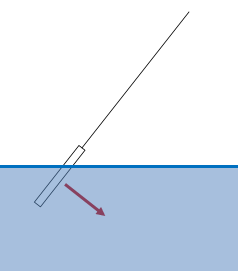
There is some advantage to be gained in lifting the boat at the start of the stroke, but quantifying that advantage is highly technical. The point is that both of these force components are beneficial to your stroke so a 30-45o blade angle on the catch is OK.
The image below shows the force when the paddle is vertical in the middle of the stroke.
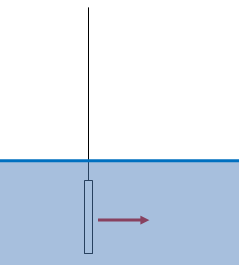
When the paddle is vertical you have all the force on the blade compressing water and propelling the boat forward. This is the ideal moment in terms of the direction of force giving most benefit.
This image shows the force when the paddle is past vertical.
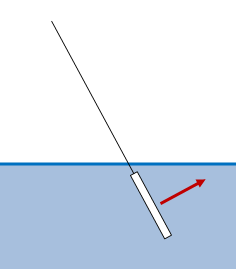
Once the paddle has past the vertical position you begin to apply an upward force to the blade which pushes the water up rather than compressing it behind, resulting in less power.
The longer the blade is in this negative position the less effective your applied force will be. This is why your coach will encourage you to keep your paddle as vertical as possible for as long as possible through the stroke. How effectively you keep your paddle vertical depends on how you use your body.
There are three sources of power in the stroke. There is the initial lift and pull you get from driving down through the shaft at the catch. There is the strong forward force that comes from pushing through your feet and legs to bring your body upright and the blade back. And there is the force you apply to the paddle by counter-rotating your body through the stroke. This counter-rotation should only be done by fit and flexible paddlers. If not done properly it can result in the paddler “twisting” which places unnatural stress on the spine. For this reason, mature age paddlers are not encouraged to counter-rotate; the benefit is outweighed by the potential for injury.
To get a good pull after the catch you should focus on pushing with your feet and legs with your core “turned on”. This brings your body back into the upright position and naturally brings the blade back through the water.
The secret is to not to focus on body rotation. It is just a natural consequence of a good stroke. Instead, concentrate on trying to poke your bottom out behind you. It can’t move backward (it’s stuck in the seat) so instead, your shoulders will naturally move forward and extend your reach. As you lean forward, hold your arms so that the blade points forward under the armpit of the person in front. This is achieved by having the outboard arm straight and the inboard arm at an open 90o angle. You can see this is the image below.
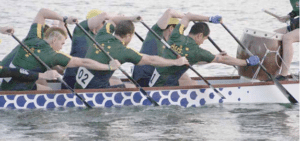
Once you are in the forward ‘catch’ position, drive the shaft down into the water with your top hand and begin pushing with your feet and thighs. This will bury the blade deep and draw it back powerfully through the water. If your outboard arm is kept as straight as possible throughout, the shaft of your paddle with stay in the vertical position for much longer and provide a more effective angle of force. The moment you bend your outside arm you will put a negative angle on the blade.
If required, body rotation can be achieved by lifting the inboard butt cheek off the seat. This frees the hips from a fixed position on the seat allowing the hips, lower back and shoulders to stay aligned as you lean forward and turn slightly towards the centre of the boat. It may not be possible to ‘see’ the butt cheek lifting. It is more a case of ‘feeling’ the butt bone rise from the seat (regardless of what the flesh around it is doing). By doing this you may gain extra stroke length on the catch and have some natural whole-body rotation to use as pulling power.
Some people seem to think that if they throw their shoulders around first, the momentum will cause the back and hip to rotate as well.
However, what often happens is that by rotating the shoulders first you end up twisting your lower back which can lead to lower back pain in the longer term. This is apparent in the image at right. The lead stroke has a definite change in spinal angle between his hips and shoulders.
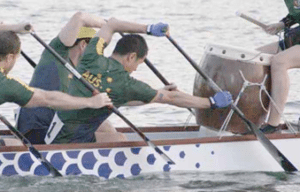
Fit and flexible paddlers can cope with this “twist” and use the “unwinding” of the body to add extra power on the blade. However, it’s particularly important that mature paddlers are encouraged to lift the butt bone to create the change in body angle. This keeps their hips, lower back and shoulders in alignment as far as is possible and helps avoid injury.
